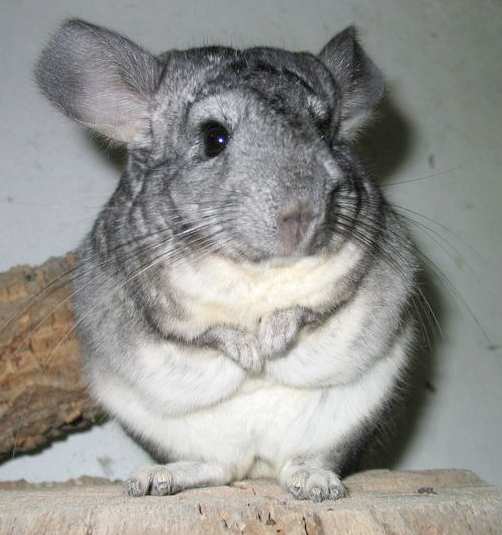|
CHINCHILLA
|
|||||||||||||||||||||||||||||||||||||||||||||||||||
|
HOME | BIOLOGY | FILMS | GEOGRAPHY | HISTORY | INDEX | INVESTORS | MUSIC | SOLAR BOATS | SPORT |
|||||||||||||||||||||||||||||||||||||||||||||||||||
|
Chinchillas and their relatives viscachas are small, crepuscular rodents native to the Andes mountains in South America and belonging to the family Chinchillidae. In Chinese, they are called lóng māo, which literally means "dragon-cat".
Chinchilla fur is considered the softest in the world and is thirty times softer than human hair. Chinchillas must regularly bathe in dust or volcanic ash to remove oil and moisture that gathers in their thick fur. In fact, they have the highest fur density of any land animal with more than 20,000 hairs per square cm. Their fur is so dense that skin parasites (such as fleas) cannot live on one lest they suffocate. Where humans grow one hair from each follicle, a chinchilla has more than fifty hairs from a single follicle.
Chinchilla
The international trade in chinchilla fur goes back to the 1500s and the animal (whose name literally means "Little Chincha") is named after the Chincha people of the Andes, who wore its soft and dense fur. By the end of the 19th century, chinchillas had become quite rare.
In 1923, Mathias F. Chapman brought the eleven wild chinchillas he had captured to the U.S. for breeding. Only three of these were female. Since the mid-1960s, chinchillas have become increasingly popular as house pets. This peculiar rodent is also studied by linguists due to its aural range of perception. It is considered the closest to that of a human.
In their native habitat, chinchillas live in burrows or crevices in rocks. They are agile jumpers and can jump up to five feet above their head. Predators in the wild include hawks, skunks, felines, and canines. In the wild chinchillas have been observed eating plants, fruits, seeds, and small insects; however, attempting to simulate or feed this formula in captivity can lead to serious illness or even death.
In nature, chinchillas are gray, while other colors have been developed in captivity. The major color mutations are: white (incomplete dominant), beige (dominant), ebony, violet (recessive) and sapphire (recessive). Variations of these mutations also exist. For example, a white mosaic is a variety of white in which the fur is tipped with silver. The white gene has an "incomplete dominance," (not completely dominant over the natural allele "standard" gray) can result in a large variety of white fur, including the mosaic variety.
In nature, chinchillas live in colonies. Chinchilla females are significantly bigger than males. Chinchillas can breed any time of the year. At 111 days, they have a very long gestation period compared to other rodents. Due to this long pregnancy, chinchillas are born fully furred and with eyes open. Litters range from one to seven babies, although the yearly average litter size is 1.45. In the case of a miscarriage, the fetus is frequently absorbed into the body of the mother.
MAMMALS:
REFERENCE and LINKS:
Racing and sport links
A taste for adventure capitalists
Solar Cola - a healthier alternative
|
